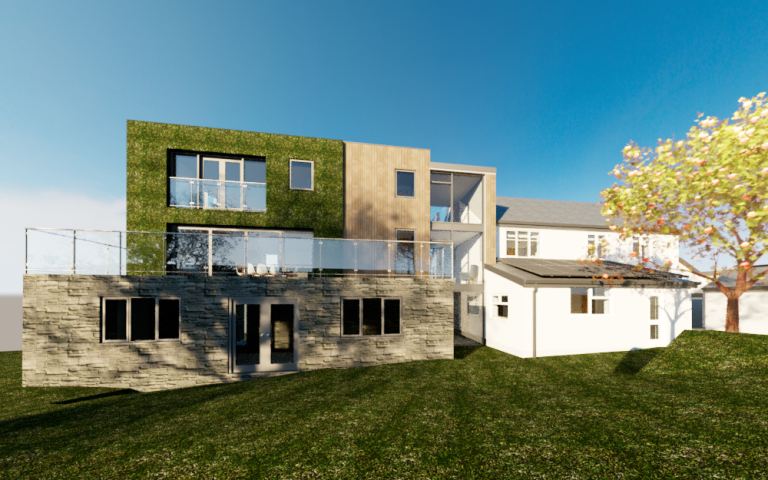Exploring Biophilic Design: Bringing Nature Into Architecture
In today's bustling urban environments, our connection with nature often takes a backseat. However, a growing movement in architecture called Biophilic Design seeks to reintroduce nature into our built spaces, creating healthier, more sustainable, and inspiring environments. At Darkin Architects we have had extensive experience incorporating Biophilic Design principles into our projects, including the integration of green walls, green roofs, and brown roofs. In this article, we will explain the concept of Biophilic Design and share some insights from our work in this exciting field.

Above: Green Wall illustrated in 3D imagery for proposed extension in Swansea
Biophilic Design is an innovative approach to architecture that aims to reconnect people with nature by incorporating natural elements and features into the built environment. It recognizes our innate affinity for nature and the positive impact it has on our physical and mental well-being. By integrating nature-inspired elements, such as plants, natural light, water, and natural materials, Biophilic Design seeks to create spaces that improve our overall quality of life.
The Three Tenets of Biophilic Design
1. Nature in the Space: This aspect involves incorporating direct experiences of nature into the design, such as plants, water features, and natural materials like wood or stone. These elements evoke a sense of connection to the natural world, improving well-being and reducing stress.
2. Nature of the Space: It focuses on creating spatial conditions that mimic natural environments or evoke the feeling of being in nature. This includes using organic shapes, patterns, and colours that reflect the natural world. By doing so, it stimulates our senses and promotes a sense of tranquillity and relaxation.
3. Natural Analogues: Natural analogues involve using materials, patterns, and textures that imitate nature, even if they are not directly derived from it. This can include incorporating biophilic wallpapers, artwork, or sculptures that evoke natural themes, enhancing the visual and tactile experience.
Darkin Architects' Experience in Biophilic Design
At Darkin Architects, we have been at the forefront of incorporating Biophilic Design principles into our projects, recognizing the importance of nature in our modern lives. Our expertise includes:
1. Green Walls: We have integrated living green walls into various projects, creating vertical gardens that not only enhance the aesthetic appeal but also improve air quality and provide a sense of natural serenity.
2. Green Roofs: Our design approach extends to green roofs, where we incorporate vegetation on rooftops, offering numerous benefits such as insulation, stormwater management, and the creation of habitats for wildlife.
3. Brown Roofs: In addition to green roofs, we have experience in designing brown roofs, which involve using local, natural materials such as rocks, logs, and soil to create rooftop habitats, attracting biodiversity and promoting ecological balance.
Biophilic Design represents a powerful way to restore our connection with nature in the built environment. By incorporating elements such as green walls, green roofs, and brown roofs, Darkin Architects embraces this design philosophy, creating spaces that promote well-being, sustainability, and harmony with the natural world. Through our ongoing commitment to Biophilic Design, we aim to continue shaping environments that inspire, rejuvenate, and support the overall health and happiness of those who inhabit them.

